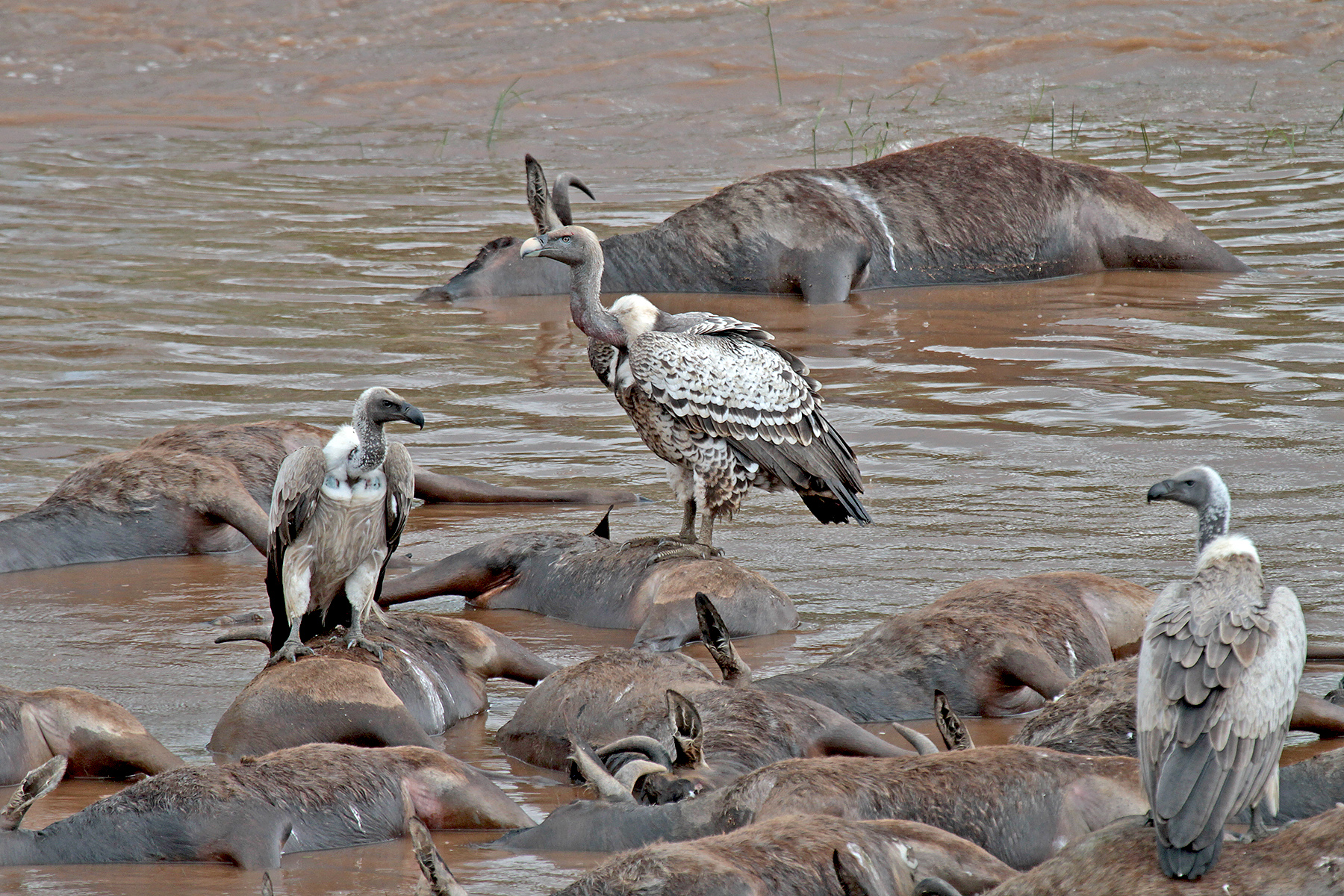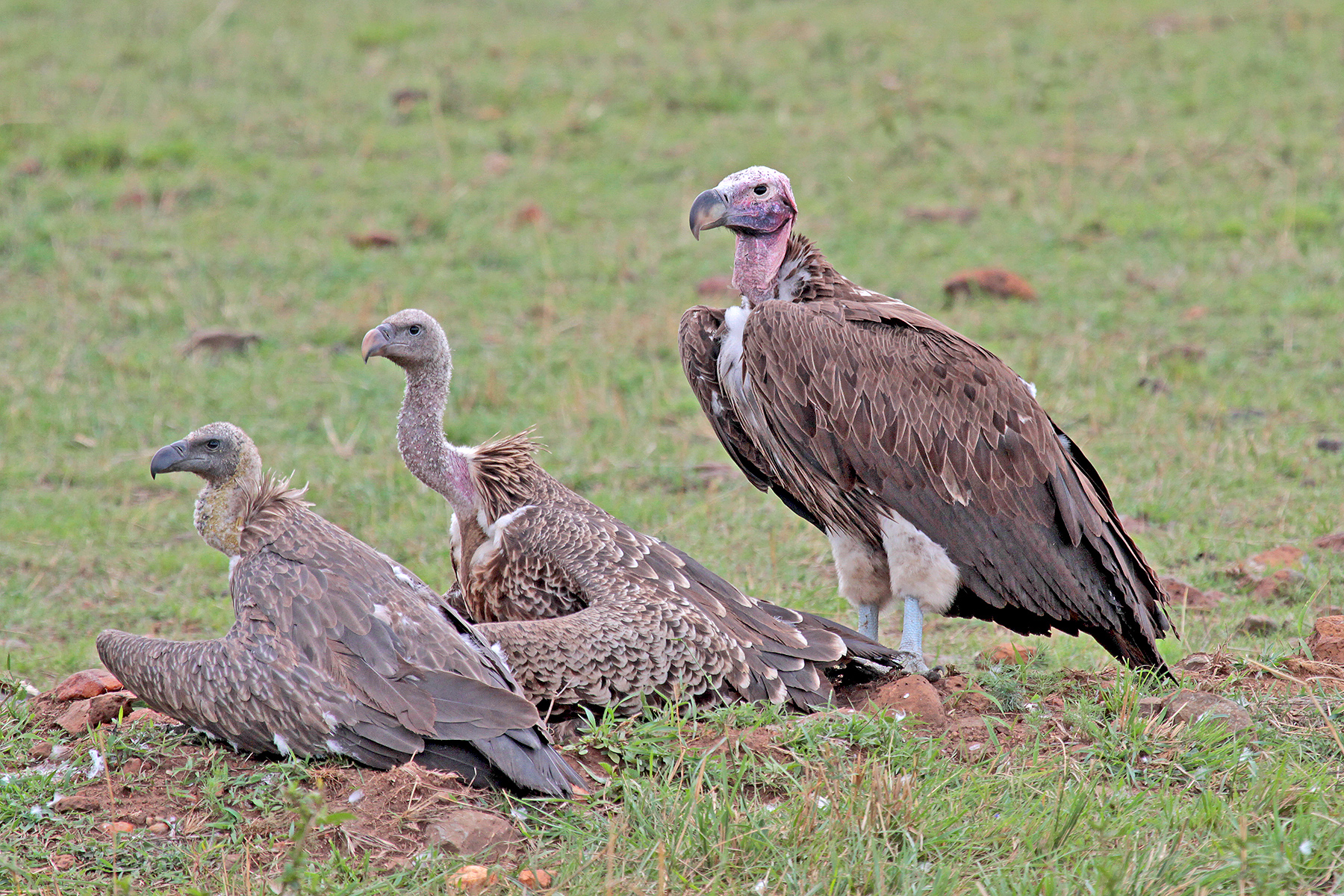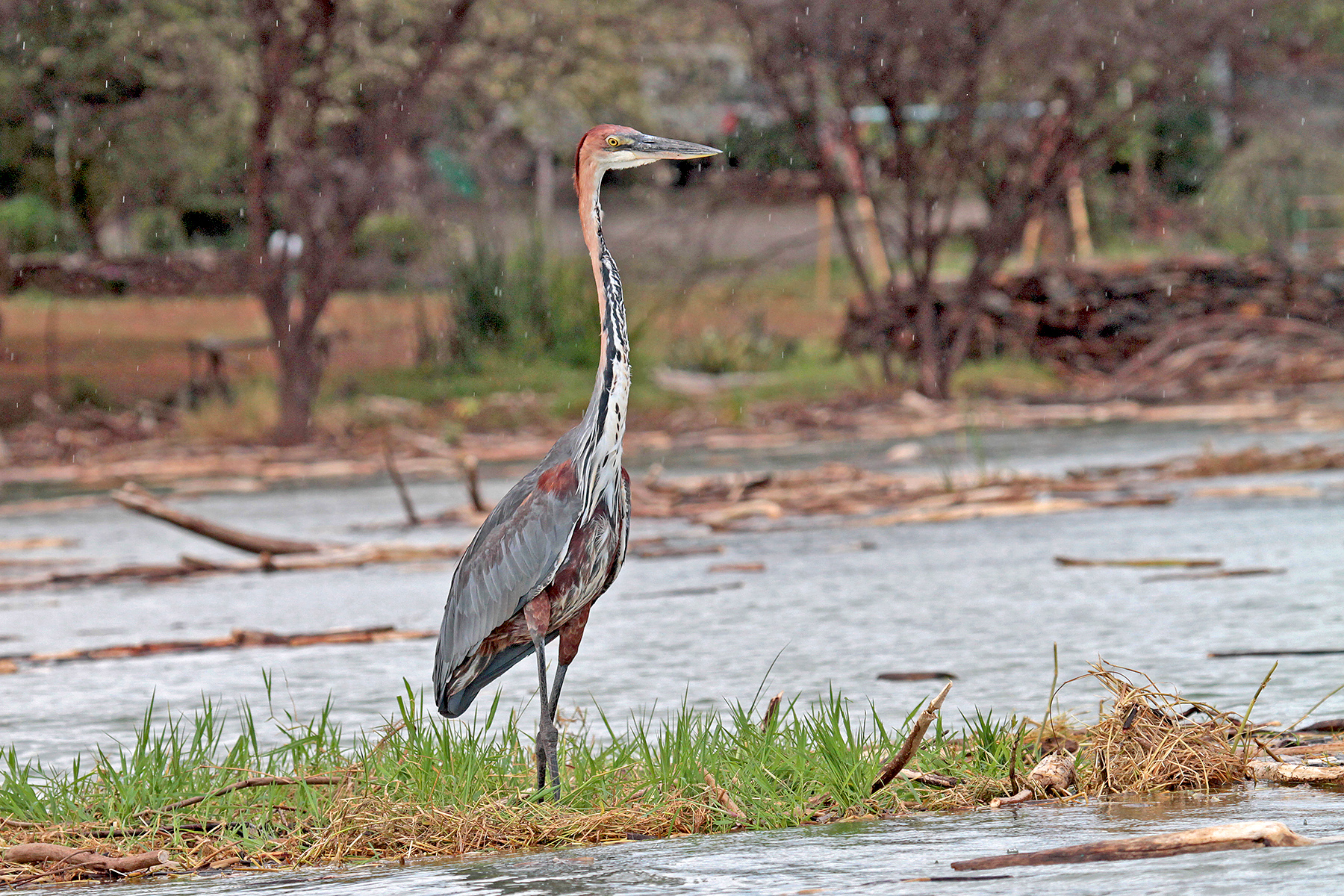SPECIALITIES OF KENYA BIRDING TOUR: DETAILED ITINERARY
Kenya: Day 1 Our Kenya Specialities birding tour begins around midday at Nairobi Wilson Airport. From there we will take a flight to Lamu airport on Manda Island on Kenya’s Indian Ocean coast, where we will stay overnight. Lamu itself is an old port town on adjacent Lamu Island, founded many centuries ago by Arab traders.
Our main purpose in coming here is to see a very special bird, the recently-described Black (or Manda) Boubou, a restricted-range endemic species which occurs only in coastal Kenya and Somalia, and which cannot be seen further south in Kenya. Other good birds at Manda are the restricted-range Eastern Black-headed Batis, Bare-eyed Thrush and the near-endemic Scaly Babbler.
Kenya: Day 2 After some early morning birding on Manda Island, we will travel southwards to Malindi and on to nearby Watamu for a three nights stay at a comfortable resort situated right on the Indian Ocean shore. We will make some birding stops en route and in the Malindi area.
Kenya: Days 3-4 Coastal Kenya is quite different from the interior of the country and many of the birds we will see here are not found inland. During our visit, we shall explore the huge and finally well-protected Arabuko-Sokoke Forest and the Indian Ocean coastline with its mangroves, mudflats, sandy beaches and coral reefs. There are some exciting specialities to be found here and the birding is a mixture of delightfully easy, bird-packed coastal wetlands and more difficult forest birding.
The famous Arabuko-Sokoke Forest can be divided roughly into three main vegetation belts, each with its attendant specialities. We shall ensure that we sample them all so that we can find as many of the specialities as possible.
The forest is thick and dense and it is no easy task to locate the wary and near-endemic Sokoke Pipit as it creeps silently through the leaf litter or display flights overhead, or the attractive East Coast Akalat, a renowned skulker. Mixed feeding flocks can hold the tiny and near-endemic Amani Sunbird, as well as Mombasa Woodpecker, Black-headed Apalis, Little Yellow Flycatcher, Forest and Pale Batises, Retz’s and Chestnut-fronted Helmetshrikes, and Plain-backed Sunbird.
The often thick and impenetrable vegetation provides cover for Yellow-bellied, Fischer’s and Lowland Tiny Greenbuls and the secretive Bearded Scrub Robin. Fischer’s Turaco, despite being colourful, can take time to track down and we will need a modicum of luck if we are to admire a Mangrove Kingfisher. If we are fortunate, there will be a flock of the little-known Forbes-Watson’s Swift hawking low over the forest. There is also a fair chance for Collared Palm Thrush.
Our local guide may well find us the diminutive and near-endemic Sokoke Scops Owl at one of its daytime roosts, but if the birds are not at home we will have to stay until dark when a duet can be built up between our guide and a calling bird. Following the soft hoots in the dark, moving cross-country through the tangled vegetation is not easy, but the thrilling reward is to finally catch sight of this special little owl caught in the spotlight beam. Other nocturnal possibilities include the range-restricted Scheffler’s Owlet (sometimes split from African Barred Owlet), African Wood Owl and Fiery-necked Nightjar.
The rar endemic Clarke’s Weaver occurs in this part of Kenya and sometimes a colony is found, which would give us a great opportunity to admire this rarely-seen bird. The localized Golden Palm Weaver is also to be found in the area.
Mammals include the impressive Golden-rumped and Four-toed Elephant Shrews, Zanj Sun Squirrel and occasionally even Caracal.
While in this rich coastal region we will also want to find two near-endemics; Violet-breasted Sunbird and the leggy Malindi Pipit. Other good birds include Northern Carmine and White-throated Bee-eaters, the restricted-range Coastal Cisticola and Purple-banded Sunbird. Ship-borne House Crows from the Indian subcontinent have colonized the coast and are a less welcome addition to the avifauna.
The dunes, pools, estuaries and mangroves also offer some marvellous bird-watching opportunities. The Sabaki River mouth (or more accurately the mouth of the Galana River, Kenya’s second-longest river) is a terrific place to watch shorebirds, gulls and terns, and, in particular, we shall be looking for the striking Crab-plover (the sole member of its family), usually present in some numbers, as well as Dimorphic Egret, Sooty Gull and Saunders’s Tern.
Other species we are likely to encounter in the coastal wetlands include Great White Pelican, Little Egret, Grey Heron, African Sacred Ibis, African Spoonbill, Yellow-billed Stork, Greater Flamingo (and sometimes Lesser Flamingo), Western Osprey, Western Marsh Harrier, Grey (or Black-bellied), Common Ringed, White-fronted, Lesser Sand and Greater Sand Plovers, Little Stint, Sanderling, Marsh, Common, Curlew and Terek Sandpipers, Bar-tailed Godwit, Eurasian Whimbrel, Common Greenshank, Ruddy Turnstone, Lesser Black-backed Gull, Gull-billed, Caspian, Greater Crested, Lesser Crested and Common Terns, and Pied Kingfisher. More uncommon possibilities include Collared Pratincole, Common Redshank, African Skimmer and Roseate Tern.
This is a great time of year for Palearctic migration through Kenya and we may well see Amur Falcons and perhaps Sooty Falcons migrating past, either here at the coast or further inland during the tour. Other migrants include Common Cuckoo, European Nightjar, European Roller, Blue-cheeked Bee-eater, Barn Swallow and Eurasian Golden Oriole.
Amongst the wealth of more widespread species to be found in the forest or more open habitats are the restricted-range Dodson’s Bulbul, East Coast Boubou and Zanzibar Red Bishop, as well as the more widespread Hadada Ibis, Yellow-billed Kite, African Goshawk, Black (or Great) Sparrowhawk, Lizard Buzzard, Southern Banded and Brown Snake Eagles, the distinctive pucherani race of the Crested Guineafowl, Red-eyed Dove, African Green Pigeon, Diederik and Klaas’s Cuckoos, African Wood Owl, Mottled and Böhm’s Spinetails, African Palm and Little Swifts, Speckled Mousebird, Green Wood-hoopoe, Trumpeter Hornbill, Green Barbet, Green Tinkerbird, Green-backed Woodpecker, African (or Grassland) Pipit, Lesser Striped Swallow, African Pied Wagtail, Sombre (or Zanzibar Sombre) Greenbul, Northern and Terrestrial Brownbuls, Eastern Nicator, Grey-backed Camaroptera, Red-tailed Ant Thrush, Ashy Flycatcher, Black-crowned Tchagra, Black-backed Puffback, Fork-tailed Drongo, Black-headed Oriole, Pied Crow, Black-bellied Starling, Collared and Olive Sunbirds, Dark-backed and Village Weavers, Red-cheeked Cordon-bleu, the shy Red-throated (or Peters’s) Twinspot, Pin-tailed Whydah and Yellow-fronted Canary.
More uncommon possibilities include African Openbill, Little Sparrowhawk, Green Malkoha (or Green Yellowbill), Thick-billed Cuckoo, Scaly-throated and Pallid Honeyguides, Gorgeous Bushshrike and Blue-mantled Crested Flycatcher.
Kenya: Day 5 Today we will head inland, bound for the Taita Hills where we will spend two nights.
We will pass through Tsavo East National Park en route and will have our first opportunity to see many species characteristic of the arid bushlands of eastern and northeastern Kenya. If we are really in luck we will come across the very uncommon Fire-fronted Bishop.
Likely new birds today include Western Cattle Egret, Crested Francolin, Yellow-necked Spurfowl, Helmeted Guineafowl, White-backed and Rüppell’s Vultures, Brown Snake Eagle, Bateleur, Tawny Eagle, Eastern Chanting Goshawk, the huge Kori Bustard, Buff-crested Bustard, Crowned and Black-headed Lapwings, Black-faced Sandgrouse, Ring-necked, Laughing and Namaqua Doves, Emerald-spotted Wood Dove, White-bellied Go-away Bird, Jacobin Cuckoo, Blue-naped Mousebird, Grey-headed Kingfisher, Lilac-breasted Roller, Little Bee-eater, Abyssinian Scimitarbill, Northern Red-billed, Von der Decken’s, Eastern Yellow-billed and African Grey Hornbills, Red-and-yellow Barbet and Lanner Falcon.
Among the likely passerines are the restricted-range Rosy-patched Bushshrike as well as White-crested Helmetshrike, Northern White-crowned Shrike, Long-tailed and Taita Fiscals, Pink-breasted and Red-winged Larks, the beautiful Golden Pipit, Pangani Longclaw (uncommon), Wattled, Superb and Fischer’s Starlings, the gorgeous Golden-breasted Starling, White-browed Scrub Robin, White-browed Sparrow-Weaver, Parrot-billed Sparrow and Red-billed and White-headed Buffalo Weavers. I
Palearctic migrants are likely to include Montagu’s Harrier, Rufous-tailed Scrub Robin, Northern, Isabelline and Pied Wheatears, Red-backed, Red-tailed and Lesser Grey Shrikes, and perhaps Isabelline Shrike.
Here or in the north there is always a chance for the rare and nomadic Scissor-tailed Kite.
Kenya: Day 6 Today we shall head even higher into the Taita Hills. This isolated massif that rises dramatically from the surrounding flat landscapes holds a number of interesting endemic specialities. We will visit a small patch of remnant forest near the very top of the Taita Hills in search of some of the rarest birds in Kenya and indeed in Africa. These are the distinctive endemic Taita Thrush, Taita Apalis and Taita White-eye. This highly threatened forest is extremely small and it is quite clear that these birds are on the very brink of their existence (both the thrush and the apalis are now considered Critically Endangered). However, the forest is now protected by law and so there is some hope. We need plenty of time in the Taita Hills as the thrush in particular can be hard to see.
Other species we should encounter in the Taita Hills, including in the drier lower zone, include Mountain and Augur Buzzards, Speckled Pigeon, Lemon Dove, Red-chested Cuckoo, African Black Swift, Silvery-cheeked Hornbill, Spot-flanked, Brown-breasted and D’Arnaud’s Barbets, Rock Martin, Red-rumped Swallow, Striped Pipit, Stripe-faced and Placid Greenbuls, Chinspot Batis, Pale Flycatcher, Yellow-throated Woodland Warbler, Tawny-flanked Prinia, the pretty White-starred Robin, Common (or Rufous-tailed) Rock Thrush, African Stonechat, Abyssinian White-eye, Northern Fiscal, White-necked Raven, Red-winged Starling, Red-billed Oxpecker, Amethyst and Variable Sunbirds, Eastern Golden and Baglafecht Weavers, Bronze Mannikin and Reichenow’s Seedeater. Palearctic migrants include Common Buzzard, Eurasian Hobby, Tree Pipit, Willow Warbler and Spotted Flycatcher.
Grey-olive Greenbul, Evergreen Forest Warbler, Red-capped Robin-Chat, Straw-tailed Whydah and Long-tailed Paradise Whydah can sometimes be found in this area and Orange Ground Thrush also occurs, although we will be very fortunate if we encounter the latter.
Kenya: Day 7 We will make a few birding stops during our journey to the slopes of Mount Kenya, where we will spend the night in the Embu region. Today, we will leave the dry thornbush and grasslands of eastern Kenya behind and ascend until we reach the well-watered uplands at the base of Mount Kenya. We should encounter a few new birds en route, probably including the handsome Black-chested Snake Eagle.
Kenya: Day 8 This morning we will visit an area of forest that is a known haunt for Abbott’s Starling, a little-known frugivorous East African endemic that is restricted to highland forest canopy in Kenya and northern Tanzania. Its tiny population is thought to be declining all over its limited range, but we do stand a good chance of being able to locate this very rare bird (which we hardly ever see in Tanzania) at this site.
Many other species are going to be new for us in this area and these are likely to include the endemic Kikuyu White-eye and the restricted-range Olive-breasted Greenbul as well as Hartlaub’s Turaco, the beautiful Narina Trogon, Moustached Tinkerbird, Tullberg’s (or Fine-banded) Woodpecker, Northern Puffback, Tropical Boubou, Grey and Black Cuckooshrikes, White-bellied Tit, Yellow-whiskered Greenbul, Black Saw-wing, White-browed Crombec, Cinnamon Bracken Warbler, the excitable Hunter’s Cisticola, White-chinned Prinia, Yellow-breasted, Chestnut-throated and Grey Apalises, Sharpe’s Starling, Tacazze and Eastern Double-collared Sunbirds, and Thick-billed Seedeater. Other possibilities include African Black Duck, Eastern Grey Woodpecker, Mountain Wagtail, the interesting vepres race of the Black-lored Babbler and White-browed Robin-Chat.
Afterwards, we will head westwards to the Nyeri area for an overnight stay. We will stop along the way to look for the restricted-range Lynes’s Cisticola.
Kenya: Day 9 Early this morning we will check out a scrubby little valley for the endangered endemic Hinde’s Babbler. The species is restricted to a narrow altitudinal belt around the southern edge of Mount Kenya. The land here is intensively cultivated and the thick vegetation that the birds need for shelter is constantly being cleared for agriculture.
Next, we will visit Aberdare National Park where we shall be wanting to see the endemic Aberdare Cisticola. Although this species is quite common, it can be skulking at times.
Other species to look for include Dusky Turtle Dove, Cape Wagtail, Cape Robin-Chat, Abyssinian (or Mountain) Thrush, Singing Cisticola, Mountain Yellow Warbler, African Dusky Flycatcher, Northern Pied Babbler, Spectacled and Holub’s Golden Weavers, Red-collared Widowbird, Kandt’s Waxbill and African Citril. Uncommon possibilities include Rufous-breasted Sparrowhawk, Scarce Swift, Abyssinian Ground Thrush and Slender-billed Starling.
Eventually, we will head back towards Mount Kenya where we will spend the night.
Along the way, in areas of short grassland and expansive cultivation, we shall be looking for a variety of open country birds. In particular, we will be on the lookout for the fantastic, near-endemic Jackson’s Widowbird that hopefully will be in its spectacular breeding plumage at this time of year. Common Quail can often be heard calling and Rufous-naped and Red-capped Larks, Plain-backed Pipit and the dapper Capped Wheatear are all to be found. Grey Crowned Crane, Green Sandpiper, Mottled and Common Swifts, and European Bee-eater may also be seen.
Kenya: Day 10 Today we will travel by 4×4 vehicle high onto the flanks of Mount Kenya, but from the roadhead we still need to hike uphill for some distance in order to find the near-endemic Elgon Francolin, a very special bird that has been seen by few birders! Another key species in this Afro-alpine moorland habitat is the range-restricted and much-wanted Scarlet-tufted Malachite Sunbird.
Good birds in this area that fortunately do not require any uphill hiking include the near-endemic Jackson’s Spurfowl, Red-fronted Parrot, Abyssinian Ground Thrush and the stunning Golden-winged and Malachite Sunbirds. Moorland Chats are confiding and easy to see in this high-altitude environment. If it is clear we will enjoy spectacular views of the mountain.
Afterwards, we will head for Shaba National Reserve for a two nights stay. We may arrive in time for some initial exploration.
As we drop in altitude and enter drier country, we shall make a stop to look for the restricted-range Boran Cisticola and the restricted-range Little Rock Thrush.
Kenya: Day 11 Shaba National Reserve and the adjoining Buffalo Springs National Reserve lie on the edge of the dry zone of northern Kenya and are scenically some of the most attractive reserves in the country. The extensive tracts of grassland, acacia savanna and thorn-bush are broken up by strips of lush riverine woodland, whilst in many areas, multiple-trunked dom palms further enhance the scenery. This diversity of habitats makes for a very rich avifauna. Our very comfortable lodge is attractively situated on the banks of the Uaso Nyiro (‘Brown Water’) River that flows through the reserves. Whilst Shaba with its lava flows has a more volcanic feel about it, Buffalo Springs National Reserve is a bit more verdant.
During our exploration of the impressive and far less visited Shaba NationalReserve, we will head out early to a lava plain that is home to the endemic Williams’s Lark, a species we see on no other Birdquest tour. We will take an armed park ranger with us so that we can walk over the open plains made up of loose lava boulders in search of this great rarity. (The ranger is insisted on by the reserve authorities, just in case of potentially dangerous wild mammals, but we have never had any such encounter.)
Some of the other major specialities of the area include Somali Ostrich, the wonderful Vulturine Guineafowl, Grant’s Wood-hoopoe, the localized Brown-tailed Rock Chat, Magpie Starling and the heavyweight Donaldson Smith’s Sparrow-Weaver. We also have a chance for Friedmann’s Lark, although seeing this uncommon and localized species is dependent on recent rain resulting in song-flighting.
We shall also be looking in particular for the somewhat comical White-headed Mousebird and Black-bellied Sunbird, both of which are perhaps most easily found in the various lodge gardens that form veritable oases in this dry landscape.
As the day warms up we will find more raptors and these are likely to include Black-winged Kite, Hooded and Lappet-faced Vultures, African Harrier-Hawk, Gabar Goshawk, the magnificent Martial Eagle, African Hawk-Eagle and the delightful Pygmy Falcon. More uncommon possibilities include the bizarre Secretarybird, Palm-nut Vulture, Shikra and Red-necked Falcon.
Other new bird species that we may well see in the reserves include the restricted-range Chestnut-headed and Fischer’s Sparrow-Larks and Pringle’s Puffback as well as Marabou Stork, Hamerkop, White-bellied Bustard, Water Thick-knee, Chestnut-bellied Sandgrouse, Mourning Collared Dove, White-browed Coucal, Pearl-spotted Owlet, Purple Rollers, Eurasian Hoopoe, Red-fronted Tinkerbird, Black-throated Barbet, Greater Honeyguide, Nubian, Bearded, African Grey and Cardinal Woodpeckers, Foxy Lark, Wire-tailed and Ethiopian Swallows, Desert Cisticola, Pale Prinia, Brown-tailed Apalis, Northern Crombec, Grey Wren-Warbler, Yellow-bellied Eremomela, Banded Parisoma, Spotted Palm Thrush, Southern Black and African Grey Flycatchers, Acacia Tit, Pygmy Batis, Slate-coloured Boubou, Brubru, Northern White-crowned Shrike, Fan-tailed Raven, Eastern Violet-backed, Hunter’s and Marico Sunbirds, Chestnut Sparrow, Yellow-spotted Petronia, Black-capped Social Weaver, Speckle-fronted, Vitelline Masked, Lesser Masked and Chestnut Weavers, Red-billed Quelea, Green-winged Pytilia, Cut-throat Finch, Red-billed Firefinch, Blue-capped Cordon-bleu, Purple Grenadier, Crimson-rumped and Black-cheeked Waxbills, African Silverbill, White-bellied Canary and Cinnamon-breasted and Somali Buntings.
More uncommon possibilities include African Cuckoo, Ashy Cisticola, Yellow-vented Eremomela, Gambaga Flycatcher and the restricted-range Steel-blue Whydah (which tends to be uncommon)
A number of Palearctic migrants will be present at the time of our visit, probably including White-throated Robin, Eastern Olivaceous and Upcher’s Warblers, and Common Whitethroat.
These fine reserves are well known for their superb selection of mammals, in particular, Grevy’s Zebra, the long-necked Southern Gerenuk, Galla Oryx and the attractive Reticulated Giraffe.
More widespread mammal species include Olive Baboon, Vervet Monkey, African Golden Wolf, African Savanna Elephant, Desert Warthog, Kirk’s Dikdik, Ellipsen Waterbuck, Bright’s Gazelle and Common Impala. Our time is limited, but we may also encounter Lion and, if we are really lucky, Leopard. Nile Crocodiles, some of a very large size, may be seen along the Uaso Nyiro.
Kenya: Day 12 After spending a final morning at Shaba/Buffalo Springs we will drive northwards through the Northern Frontier Province to remote Marsabit, a place well off the normal birding circuit, for a two nights stay.
At first, the thorn-bush landscape is enlivened by views of Lololokwi Mountain and the distant Matthews Range, but after some time the Marsabit Massif looms ever larger on the northern horizon. The Marsabit National Reserve itself protects the interesting relict forest, grassland and beautiful crater lakes on the mountain, whilst to the north lies the destination of greater interest to birders, the bleak Dida Galgalu Desert.
As we get increasingly further north, we will keep a lookout for such specialities as Bristle-crowned Starling and Somali Crow. We could also encounter our first Heuglin’s Bustard.
Kenya: Day 13 While based at Marsabit we will explore the southern edge of the Dida Galgalu Desert. The far northern desert region of Kenya is an excellent area for birds and holds some little-known, restricted-range specialities. On the northern horizon, the far-off Huri Hills stretch away to the Ethiopian frontier and as the vegetation becomes sparser and the barren black lava flows take over the landscape becomes increasingly bleak and inhospitable.
Among the major targets that we will be looking for in the Marsabit region are the splendid Heuglin’s Bustard (we have never missed it!), Masked Lark, Somali Crombec and the pretty little Somali Sparrow. Huge flocks of Chestnut-headed Sparrow-Larks flush from the roadside, restricted-range Somali Fiscals are very common and both Thekla and Crested Larks live side by side here, the latter preferring the sandier habitats also favoured by the restricted-range Somali Courser. We should also come across the restricted-range Short-tailed Lark and Tiny Cisticola and the more widely distributed Shining Sunbird. We may come across Lichtenstein’s Sandgrouse scratching for food amongst the rocks, while Greater Kestrels use the few bushes as lookout posts and if we are lucky we will find a Greyish Eagle Owl at a daytime roost.
Kenya: Day 14 Today we will partly retrace our steps southwards and then travel westwards until we reach Lake Baringo where we will stay for two nights. We will make a few birding stops along the way.
Kenya: Day 15 Lake Baringo is situated in dry, rocky country clothed in acacia woodland and is the haunt of a number of avian specialities. During our stay, we will explore the lakeshore, the surrounding woodland and the sheer cliffs that rise up suddenly to the west of the lake.
The Lake Baringo area provides our only opportunity to see the near-endemic Jackson’s Hornbill and the restricted-range and patchily-distributed Northern Masked Weaver. At this season, the latter breeds by the lake alongside the attractive, restricted-range Golden-backed Weaver. At the nearby cliffs, we shall look for the restricted-range Hemprich’s Hornbill.
Along the lakeshore and in the woodland, we may well encounter such birds as Common Ostrich, Black-crowned Night Heron, Little Bittern, Striated, Squacco, Black-headed, Goliath and Purple Herons, Great Egret, Reed Cormorant, African Darter, White-faced and perhaps Fulvous Whistling Ducks, Egyptian Goose, Dark Chanting Goshawk, African Fish Eagle, Black Crake, African Swamphen, Common Moorhen, Black-winged Stilt, Spur-winged Lapwing, African Jacana, Three-banded Plover, Wood Sandpiper, Meyer’s Parrot, Woodland, Malachite and Giant Kingfishers, Red-fronted Barbet, Lesser Honeyguide, Brown Babbler, Rufous Chatterer, Grey Tit-Flycatcher (or Lead-coloured Flycatcher), Sedge and Buff-bellied Warblers, Spotted Morning Thrush, Mouse-coloured Penduline Tit, Orange-breasted and Grey-headed Bushshrikes, Grey-backed Fiscal, Greater Blue-eared and Violet-backed Starlings, Beautiful Sunbird, White-billed Buffalo Weaver, Little Weaver, Yellow-crowned Bishop and Village Indigobird. We may also see Northern Red Bishops, and when they are displaying the males seem like animated scarlet fireballs. Occasionally, if conditions are right, Allen’s Gallinule puts in an appearance.
We could find some nocturnal birds during our visit with possibilities including Three-banded (or Heuglin’s) Courser, Slender-tailed Nightjar, African Scops Owl, Northern White-faced Owl, Greyish Eagle-Owl and the even larger Verreaux’s Eagle-Owl.
Kenya: Day 16 Today we will drive westwards to Kakamega Forest for a two nights stay.
We will make a few stops along the way for birds like the restricted-range White-crested Turaco and the more widely distributed Double-toothed Barbet and Chestnut-crowned Sparrow-Weaver.
We will arrive at Kakamega Forest in time for some initial exploration.
Kenya: Day 17 Kakamega Forest is a unique area of evergreen forest near the western frontier of Kenya. The flora and fauna of the forest is closely akin to that of the Central African rainforests and many of the birds found here are at the easternmost point of their distribution.
Of great significance in these days of taxonomic change is the Grey-chested Babbler (formerly known as Grey-chested Illadopsis), which is now treated as one of only three members of a distinct family. (The other two members are Spot-throat and Dapple-throat.) Kakamega is surely the very best place in the species’ range to get good views of this retiring little critter.
The other two main target species of the forest are the restricted-range Turner’s Eremomela and Uganda Woodland Warbler, the first of which is not seen on bird tours to Uganda (the only other country it occurs in), while the second can be difficult to find there. We shall be listening for their calls and scanning the canopy in order to find these charming little warblers.
Another great bird of Kakamega is the Blue-headed Bee-eater and this must surely be the easiest location to see this beautiful bird, although it is still not a certainty.
The forest day typically begins with an impressive dawn chorus. Huge Black-and-white-casqued Hornbills noisily leave their roosts and ridiculously top-knotted Great Blue Turacos emit their distinctive guttural cries from high inside the canopy. Out on the dead snags, silhouetted against the sky, sit Grey-throated Barbets with their startling pale eyes and strange nasal tufts. They are sometimes joined by Stuhlmann’s Starlings, while attractive White-headed Saw-wings fly overhead. Our attention will soon turn, however, to the skulking birds of the undergrowth. The persistent squeak of Black-faced Rufous Warblers and the joyful duets of Chubb’s Cisticolas are commonly-heard sounds at Kakamega, but we will also be hoping for such secretive species as Brown-chested Alethe and Brown Illadopsis and Scaly-breasted Illadopsis to betray their presence by their whistled calls.
Greenbuls are a feature of the forest and we shall be aiming to locate Red-tailed Bristlebill and Plain (or Cameroon Sombre), Little Grey, Ansorge’s, Little, Slender-billed, Kakamega, Cabanis’s, Toro Olive, Honeyguide and Joyful Greenbuls
During our stay at Kakamega, we will find many additional species. Likely new birds include White-spotted Flufftail, Blue-spotted Wood Dove, Black-billed Turaco, Red-chested Owlet, Cinnamon-chested Bee-eater, Yellow-spotted, Hairy-breasted and Yellow-billed Barbets, Yellow-rumped Tinkerbird, Yellow-crested, Buff-spotted and Brown-eared Woodpeckers, Equatorial Akalat, Grey-winged, Blue-shouldered and Snowy-headed Robin Chats, White-tailed Ant Thrush, African Thrush, Black-faced Prinia, Olive-green Camaroptera, Buff-throated and Black-collared Apalises, Grey-capped Warbler, Green Hylia, Mountain Illadopsis, Chapin’s, Dusky Crested and African Blue Flycatchers, Jameson’s Wattle-eye, African Yellow White-eye, Dusky Tit, Bocage’s and Lühder’s Bushshrikes, Pink-footed Puffback, Mackinnon’s Fiscal, Square-tailed Drongo, Western Oriole, Grey-chinned, Green-throated, Green-headed, Bronzy and Olive-bellied Sunbirds, Northern Grey-headed Sparrow, Black-billed, Black-necked, Brown-capped and Vieillot’s Black Weavers, Red-headed Malimbe, White-breasted and Grey-headed Nigritas, Red-headed Bluebill, Black-crowned Waxbill, Black-and-white Mannikin and Southern Citril.
More uncommon possibilities include Western Banded Snake Eagle, Ayres’s Hawk-Eagle, Scaly Francolin, Grey Parrot, Blue Malkoha (or Blue Yellowbill), Levaillant’s Cuckoo, Thick-billed and Least Honeyguides, African Broadbill, African Shrike-flycatcher, Chestnut and Yellow-bellied Wattle-eyes, Petit’s and Purple-throated Cuckooshrikes, Yellow-throated Leaflove, Velvet-mantled Drongo, Pale-breasted Illadopsis, Southern Hyliota and Oriole Finch.
Mammals such as Guereza Colobus, Red-tailed Monkey and the ‘blue’ form of the Gentle Monkey can also be seen in the forest.
Kenya: Day 18 After a final morning at Kakamega we will transfer to Lake Nakuru for an overnight stay.
Kenya: Day 19 Lake Nakuru is perhaps the most famous of the Rift Valley ‘bird lakes’. Surrounded by attractive mature yellow ‘fever trees’ and arid hills peppered with candelabra euphorbias, the lake sometimes holds spectacular concentrations of Lesser Flamingos and smaller numbers of Greater Flamingos (although at other times the numbers of Lesser Flamingos are much smaller).
Our lodge garden can be a good place to look for the restricted-range Hildebrandt’s Francolin and the patchily-distributed Red-throated Wryneck. Red-headed Weavers build their long tunnel-entrance nests here, Mocking Cliff Chats can often be seen hopping on the roofs of the chalets and Arrow-marked and Black-lored Babblers squabble from the bushes.
The trees and scrub surrounding the lake provide a home for roving flocks of helmetshrikes that can contain both White Helmetshrike and the near-endemic Grey-crested Helmetshrike. The latter is much scarcer than the former, but we still have a good chance of success.
Other species may well find in this habitat include Striped Kingfisher, Common Scimitarbill, Broad-billed Roller, White-headed Barbet, Dark-capped Bulbul, Red-faced Crombec, Brown-crowned Tchagra, Scarlet-chested Sunbird and Speke’s Weaver. African Firefinch and Common Waxbill are also possible. The Fischer’s Lovebirds at Nakuru probably originate from escaped cagebirds as this species is considered a Tanzanian endemic.
In the grasslands and open areas, we will look for the restricted-range Kenya Sparrow, as well as Coqui Francolin, Long-crested Eagle, African Hoopoe, White-fronted Bee-eater, Yellow-throated Longclaw, Whinchat, Anteater Chat, Abyssinian Wheatear, Rattling Cisticola and Yellow Bishop. In the skies overhead we should keep an eye open for Horus, Nyanza and perhaps White-rumped Swifts. Wahlberg’s Eagle, Black-bellied Bustard and the huge Southern Ground Hornbill are also possible.
At various lookout points around the vast shallow soda lake, we should find Little Grebe, Great White and Pink-backed Pelicans, White-breasted Cormorant, Intermediate Egret, Glossy Ibis, Cape Teal, Yellow-billed Duck, Northern Shoveler, Western Marsh Harrier, Red-knobbed Coot, Pied Avocet, Blacksmith Lapwing, Kittlitz’s Plover, Greater Painted-snipe, Ruff, Black-headed and Grey-headed Gulls, Whiskered and White-winged Terns, and Western Yellow Wagtail. Sometimes Black-necked (or Eared) Grebe, Great Crested Grebes, Spotted Redshank and Red-throated Pipit are also present.
There are plenty of large mammals at Nakuru, including a healthy introduced population of White Rhinoceros. We may also find the increasingly rare Black Rhinoceros. Nakuru is one of the best places in Kenya for seeing Leopard, but we will need a lot of luck if we are to come across one during our short visit.
This afternoon we will explore some natural tussock grassland to the west of the Aberdare Mountains. This is a habitat that is fast disappearing under cultivation but is the required habitat of the endemic Sharpe’s Longclaw. We shall stop wherever we find suitable areas and we have an excellent chance of locating this rare bird. The same habitat is shared by Wing-snapping (or Ayres’s) Cisticola, Cape Crow and Long-tailed Widowbird. Small ponds host Red-billed and Hottentot Teals, Levaillant’s Cisticola and sometimes African Snipe.
Afterwards, we will drive to Nairobi, where our Kenya Specialities birding tour ends this evening at Jomo Kenyatta International Airport.


























































































